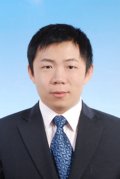 In this thesis the focus was on azobenzene photo-switches, as dynamic building blocks.
In this thesis the focus was on azobenzene photo-switches, as dynamic building blocks.
‘We started to study fluorinated azobenzenes,’ He Huang says. ‘Especially their application in supramolecular materials, for kinetic control and visible-light controlled switching, is very promising.’
First, two strategies (ortho-fluorination and axial chirality) were combined, in azobenzene-based dynamic dopants for liquid crystals. ’These chiral dopants display better cis-form stability than their nonfluorinated counterparts,’ He says. ‘Long-lived helical structures with cis-state dopant, could be created by irradiation. I strongly believe, this cholesteric liquid crystal will be potentially applied, n optical display devices or in photo-responsive actuators.’
It was shown that, by light-triggered photo-isomerization, photoswitches are transferable from one host cavity to the other, and reversibly. Used here were two common host cavities: β-cyclodextrin and cucurbit[8]uril.
Further, host-guest chemistry of ortho-fluorinated azobenzenes, was used in the design of multivalent architectures. The final aim here was to build dynamic supramolecular nanoparticles, that would display photo-triggered self-assembly.
‘Working on a fundamental level, in various exciting application fields, was very rewarding,’ He Huang says. ‘We also studied azobenzene-based photo-switches, to be employed as photo-responsive ligands for nanoplatelets of an inorganic semi-conductor. Upon irradiation, face-to-face self-assembly of the nanoplatelets took place, to form supra-particular ribbons.’
Closely collaborating with Mark Smithers and Rico Keim, from the Mesa+ Nanolab, He Huang valued as a rich experience.
‘I learnt to work systematically, and to be very patient,’ He says. ‘Complex processes call for proper and complete preparation. And when results appear, the need for critical observations stays essential, to verify the outcomes and to explain the results.’
Early stages
Working from scratch, He Huang was especially delighted, and excited, to see his first target-molecules in the NMR spectrometer.
‘This happened in an early stage of my PhD project already,’ he says. ‘But not all chapters went without obstacles. The work on the host cavities, for example, took some set-backs. The first concept we came up with, didn’t work.’
‘All in all, it was fascinating to find that focussing on azobenzene, proved worthwhile on so many topics. Changing the shape of the material - using light only, thus transferring energy – led to new functional properties.’
Future
In summary: a bottom-up approach to build dynamic smart materials proved feasible, from molecular engineering of azobenzene-based switches, up to their integration into different types of supramolecular materials, including: liquid crystals, host-guest complexes and colloidal inorganic nano-objects.
‘In future work, researchers will keep on developing new engineering strategies and methods of molecular switches, as well as on studying mechanisms of transducing molecular switching, across multiple length scales,’ according to He.
After his Defence He Huang plans to look for a job within industry. ‘As a person, I am not a 100% self-determined to pursue a career in academics,’ he says. ‘In industry an R&D job will suit me very well, most likely within a larger company, as in chemistry small companies are not present in large numbers. As Mesa+ hosts many research areas, I learnt to be open-minded and curious about other topics and research areas. That will certainly help me to find a new job, and in finding my way within chemical industry.’
